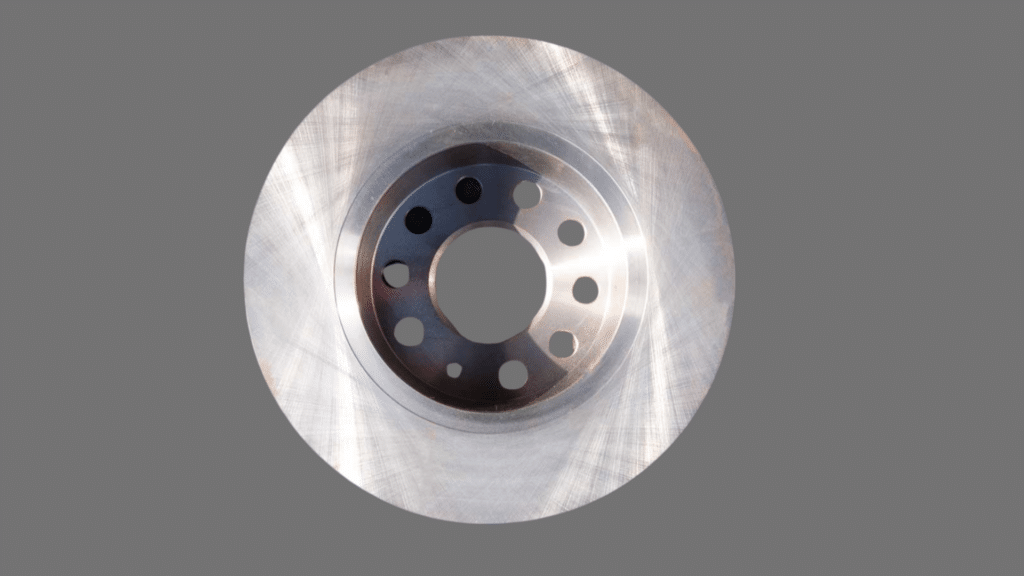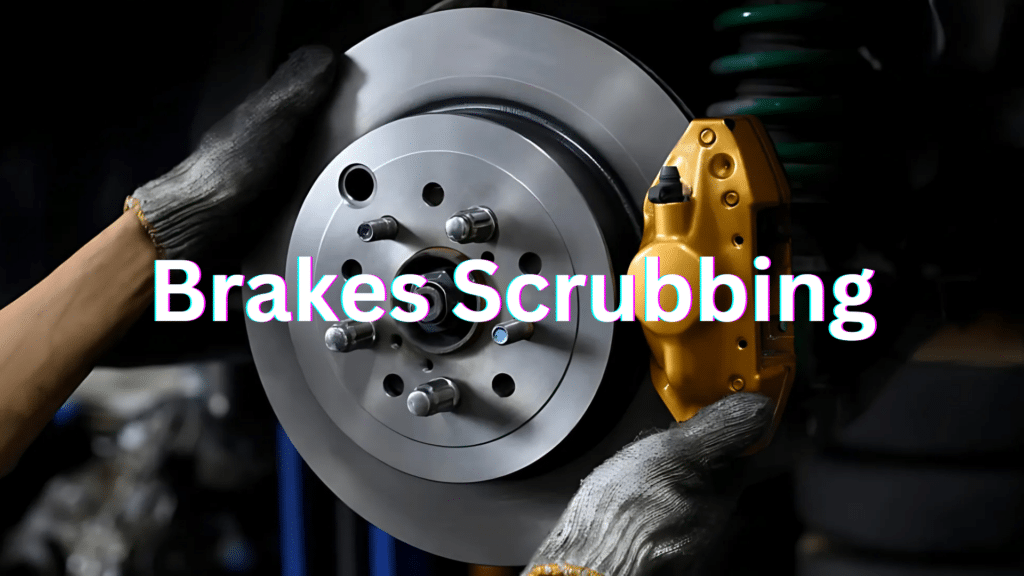Brake scrubbing is the rough or grinding sensation felt when applying the brakes. It often happens when brake components wear down, rust, or develop uneven surfaces.
This issue can create noises like squeaking, grinding, or a scraping sound, affecting the smoothness of braking.
It usually occurs due to worn brake pads, rusted or warped rotors, or debris stuck in the braking system.
Poor alignment or uneven brake wear can also contribute to scrubbing, making the brakes less effective.
Ignoring brake scrubbing can reduce stopping power, longer braking distances, and even damage to the brake system.
Recognizing early signs, such as vibrations in the brake pedal or unusual sounds, helps prevent costly repairs and ensures safer driving conditions.
What Causes Brake Scrubbing?

Brake scrubbing can happen for many reasons, often leading to reduced braking efficiency and strange noises when stopping.
Common causes include worn-out brake pads, damaged rotors, debris in the brake system, and faulty calipers.
Addressing these issues early can prevent costly repairs and improve vehicle safety.
Proper maintenance and inspections help keep the braking system in good condition and prevent scrubbing from affecting driving performance.
Worn Brake Pads
Brake pads wear down over time, and once they become too thin, they can cause a grinding or scrubbing sensation when braking.
This happens because the pad’s metal backing begins to contact the rotor. Ignoring this issue can damage the rotor, reducing braking performance.
Signs of worn brake pads include a squealing noise, reduced braking power, and vibrations in the pedal.
Replacing brake pads when they reach the recommended thickness helps prevent further damage to the rotors and ensures smooth braking.
Damaged or Warped Rotors
Brake rotors play a key role in stopping the vehicle. When they become uneven, grooved, or warped due to heat or wear, they cause brake scrubbing.
This leads to vibrations, inconsistent braking, and a rough stopping experience.
Resurfacing the rotors may be an option if the damage is minor, but in many cases, replacing them is the best solution.
To check for rotor wear, inspect them for visible grooves, rust, or discoloration.
If braking feels uneven or there are pulsations in the brake pedal, the rotors may need attention.
Dirt and Debris in the Brakes
Small rocks, dust, and other debris can get stuck between the brake pads and rotors. When this happens, braking may feel rough, and drivers might hear a scraping sound.
This is common in off-road driving or after driving through dirt, gravel, or wet conditions.
Symptoms of debris-related brake scrubbing include grinding noises and a sudden change in braking smoothness.
Cleaning the brakes by removing the wheels and inspecting for trapped debris can help fix the issue.
Compressed air or brake cleaner safely clears out dust and small particles without harming the brake components.
Faulty Brake Calipers
Brake calipers control the movement of the brake pads, ensuring they make even contact with the rotors.
When calipers become stuck or fail to function properly, they can cause uneven brake wear, which can lead to scrubbing.
A malfunctioning caliper may cause one side of the brakes to wear faster than the other, reducing stopping power and potentially causing steering issues.
Signs of a faulty caliper include pulling to one side when braking, uneven brake pad wear, and fluid leaks near the caliper.
If the caliper does not move freely or shows signs of corrosion, it may need repair or replacement to restore proper braking function.
How to Fix Brake Scrubbing
Fixing brake scrubbing involves diagnosing the root cause and applying the right solution.
Worn brake pads, damaged rotors, trapped debris, or faulty calipers can all contribute to this issue.
Regular inspections and timely repairs help restore smooth braking and prevent further damage.
While some fixes can be done at home, more serious issues may require professional attention.
Inspecting and Replacing Brake Pads
Brake pads wear down over time, leading to scrubbing or grinding sounds. Checking pad thickness regularly helps determine when a replacement is needed.
- Remove the wheel to inspect the brake pads.
- If the pads are thinner than ¼ inch, replace them immediately.
- Choose high-quality pads that match the vehicle’s braking system.
- Install the new pads, ensuring they fit securely in the caliper bracket.
- Test the brakes by pressing the pedal a few times to ensure proper contact with the rotor.
Replacing worn pads on time prevents further damage to the rotors and ensures smooth braking.
Checking and Resurfacing Brake Rotors
Brake rotors must be smooth and even for proper braking. If they are grooved, warped, or too thin, they may need resurfacing or replacement.
- Check for visible grooves, rust, or warping on the rotor surface.
- A professional can resurface the rotors to create a smooth braking surface if the damage is mild.
- Replacing the rotors is the safest option if they are severely worn or too thin.
- Always replace rotors in pairs to maintain balanced braking.
Ignoring rotor issues can cause uneven braking and reduce stopping power, making driving unsafe.
Cleaning the Brake System
Dust, dirt, and small debris can build up in the braking system, causing scrubbing noises and reduced performance. Cleaning the components helps maintain smooth operation.
- Remove the wheel and inspect the brake components for dirt and debris.
- Use brake cleaner spray to remove dust without damaging parts.
- If small rocks or debris are lodged between the pads and rotors, gently remove them with a soft brush or compressed air.
- Apply a small amount of brake lubricant to moving parts to prevent noise and ensure smooth operation.
Keeping the brakes clean reduces wear and extends their lifespan.
Adjusting or Replacing Brake Calipers
Stuck or faulty brake calipers can cause uneven braking, leading to scrubbing. If a caliper does not release properly, it may need adjustment or replacement.
- Inspect the caliper for signs of wear, rust, or leakage.
- If the caliper sticks, try lubricating the guide pins to restore movement.
- If the caliper is severely corroded or not functioning correctly, replace it with a new one.
- After installation, bleed the brakes to remove air and ensure proper brake fluid flow.
Replacing a faulty caliper restores even brake pad wear and improves braking efficiency.
Preventing Brake Scrubbing in the Future
Regular brake maintenance helps prevent scrubbing and extends the life of brake components.
Simple habits like routine inspections, smooth driving, and keeping the braking system clean can prevent excessive wear.
Addressing small issues early avoids costly repairs and ensures safe braking performance.
Routine Brake Inspections
Regular inspections help catch brake wear before it becomes a serious problem.
Checking brake components at recommended intervals ensures they function properly.
Inspect brake pads and rotors every 10,000 to 15,000 miles or during routine service.
Look for signs of wear, such as thinning pads, grooves in the rotors, or unusual noises while braking.
Testing braking response by applying gradual pressure helps check for vibrations or delays. Early detection of brake issues prevents scrubbing and costly repairs.
Proper Driving Habits
The way a driver uses the brakes affects their lifespan. Avoiding harsh braking and using controlled stops can reduce wear.
Slowing down gradually instead of slamming on the brakes helps preserve brake pads. Keeping a safe distance from other vehicles reduces the need for sudden stops.
Downshifting or using engine braking when driving downhill takes the pressure off the braking system.
Smooth driving keeps brake pads and rotors in good condition, reducing the chances of scrubbing.
Keeping the Brake System Clean
Dirt, dust, and moisture can build up on brake components, causing scrubbing noises and reduced performance. Keeping the brakes clean prevents these issues.
Washing wheels and brake components regularly remove dust and grime. A brake cleaner spray can help clear buildup on pads and rotors.
If rust forms on the rotors, driving at moderate speeds and applying the brakes gently can help clear the surface.
A clean brake system functions smoothly and lasts longer, ensuring reliable stopping power.
Conclusion
Brake scrubbing is a common issue that can affect braking performance and safety. It often happens due to worn brake pads, damaged rotors, dirt buildup, or faulty calipers.
Identifying the cause early can prevent more serious problems and costly repairs.
Timely maintenance is the best way to keep brakes in good condition. Regularly inspecting brake pads and rotors, keeping the system clean, and using smooth driving habits all help reduce wear.
Addressing small issues before they worsen ensures safer and more effective braking.
Taking care of the braking system improves vehicle performance and extends the life of its components.
Keeping up with maintenance and repairs helps prevent brake scrubbing and keeps the car running smoothly.
Frequently Asked Questions
What Is Brake Scrubbing?
Brake scrubbing is a grinding or scraping noise that occurs when brake pads, rotors, or other components wear down or become damaged. It can reduce braking performance and should be addressed quickly.
Can I Still Drive if My Brakes Are Scrubbing?
Driving with scrubbing brakes is not safe. It can cause further damage to the brake system, reduce stopping power, and increase the risk of brake failure. It is best to inspect and repair the issue as soon as possible.
How Do I Know if My Brake Pads Are Causing Scrubbing?
If brake pads are too thin, they may cause a grinding sound when braking. Other signs include squeaking noises, longer stopping distances, and visible wear on the pads. Checking the pads’ thickness can help confirm the issue.
Do I Need to Replace or Resurface My Rotors for Scrubbing Brakes?
If rotors have deep grooves, uneven wear, or warping, they may need to be resurfaced or replaced. Resurfacing can sometimes fix minor wear, but severe damage requires new rotors for safe braking.
How Can I Prevent Brake Scrubbing?
Regular brake inspections, smooth braking habits, and keeping the brake system clean can help prevent scrubbing. Replacing worn-out brake pads and maintaining proper rotor conditions also reduces the risk of brake issues.
Should I Fix the Brake Scrubbing Myself or Go to A Mechanic?
If the issue is minor, such as dirt buildup or replacing brake pads, DIY repairs may be possible. However, if there is rotor damage, caliper issues, or uncertainty about the cause, it is best to seek professional help.


